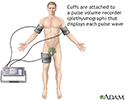Plethysmography
Respiratory inductance plethysmography; Penile pulse volume recording; Pulse volume recordings; Segmental pulse volume recordingsPlethysmography measures changes in volume in different parts of the body. The test may be done to check for blood clots in the arms and legs. It is also done to measure how much air you can hold in your lungs.
Blood clots in the arms and legs
Limb plethysmography is a test that compares blood pressure in the legs and arms.

Much air you can hold in your lungs
Lung plethysmography is a test used to measure how much air you can hold in your lungs.
Penile pulse volume recording is a type of this test. It is done on the penis to check for causes of erectile dysfunction.
Erectile dysfunction
An erection problem occurs when a man cannot get or keep an erection that is firm enough for intercourse. You may not be able to get an erection at ...

Most commonly, this test is performed to check blood flow in the arteries of the legs. This is done in people with conditions like hardening of the arteries (atherosclerosis). Atherosclerosis causes pain during exercise or poor healing of leg wounds.
Hardening of the arteries
Atherosclerosis, sometimes called "hardening of the arteries," occurs when fat, cholesterol, and other substances build up in the walls of arteries. ...

Related tests include:
-
Vascular ultrasound
Vascular ultrasound
A duplex ultrasound is a test to see how blood moves through your arteries and veins.
 ImageRead Article Now Book Mark Article
ImageRead Article Now Book Mark Article - Ankle brachial indices
References
Burnett AL, Ramasamy R. Evaluation and management of erectile dysfunction. In: Partin AW, Dmochowski RR, Kavoussi LR, Peters CA, eds. Campbell-Walsh-Wein Urology. 12th ed. Philadelphia, PA: Elsevier; 2021:chap 69.
Lohr J, Zarkowsky DS. Vascular laboratory: venous physiologic assessment. In: Sidawy AN, Perler BA, eds. Rutherford's Vascular Surgery and Endovascular Therapy. 10th ed. Philadelphia, PA: Elsevier; 2023:chap 24.
Recht MH, Muck PE. Vascular laboratory: arterial physiologic assessment. In: Sidawy AN, Perler BA, eds. Rutherford's Vascular Surgery and Endovascular Therapy. 10th ed. Philadelphia, PA: Elsevier; 2023:chap 21.
-
Plethysmography - illustration
A plethysmography test is performed by placing blood pressure cuffs on the extremities to measure the systolic pressure. The cuffs are then attached to a pulse volume recorder (plethysmograph) that displays each pulse wave. The test compares the systolic blood pressure of the lower extremity to the upper extremity, to help rule out disease that blocks the arteries in the extremities.
Plethysmography
illustration
-
Plethysmography - illustration
A plethysmography test is performed by placing blood pressure cuffs on the extremities to measure the systolic pressure. The cuffs are then attached to a pulse volume recorder (plethysmograph) that displays each pulse wave. The test compares the systolic blood pressure of the lower extremity to the upper extremity, to help rule out disease that blocks the arteries in the extremities.
Plethysmography
illustration
Review Date: 7/15/2024
Reviewed By: Jason Levy, MD, FSIR, Northside Radiology Associates, Atlanta, GA. Also reviewed by David C. Dugdale, MD, Medical Director, Brenda Conaway, Editorial Director, and the A.D.A.M. Editorial team.


